Tesco Human Resource Management: Trends, Challenges, and Practices
VerifiedAdded on 2020/05/16
|12
|2810
|88
Report
AI Summary
This report provides a comprehensive analysis of human resource management (HRM) practices at Tesco. It begins with an introduction to HRM and its significance in driving business success, followed by an overview of current trends and challenges in people resourcing, such as the rise of social media recruiting and the complexities of managing a globalized workforce. The report then delves into Tesco's specific recruitment and selection processes, detailing job analysis, job descriptions, person specifications, shortlisting methods, and interviewing techniques. It also explores Tesco's induction and training programs, emphasizing their importance in integrating new employees and enhancing existing employees' skills and competencies. The report concludes by highlighting the challenges associated with these HRM practices, such as effectively planned induction programs, engaging training sessions, and the impact of a global workforce. Overall, the report offers valuable insights into Tesco's strategic approach to managing its workforce and addressing the evolving demands of the HRM landscape.
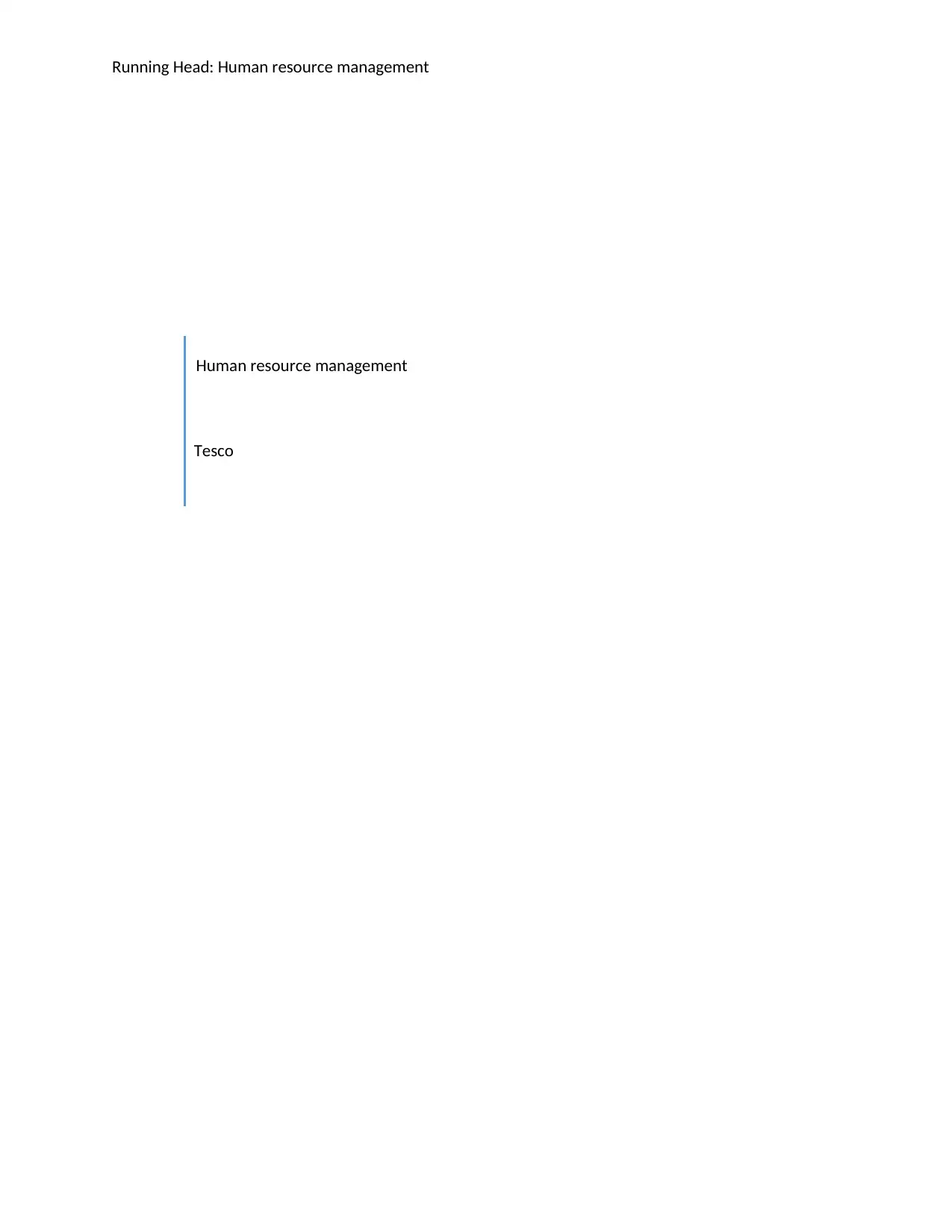
Running Head: Human resource management
Human resource management
Tesco
Human resource management
Tesco
Paraphrase This Document
Need a fresh take? Get an instant paraphrase of this document with our AI Paraphraser

Human resource management 1
Contents
Introduction......................................................................................................................................1
Trends and challenges in people resourcing....................................................................................1
Trends...........................................................................................................................................1
Challenges....................................................................................................................................2
Recruitment and selection................................................................................................................2
Job analysis..................................................................................................................................2
Job description and person specification.....................................................................................3
Short listing..................................................................................................................................3
Interviewing.................................................................................................................................4
Induction process.............................................................................................................................4
Training programs...........................................................................................................................5
Conclusion.......................................................................................................................................7
References........................................................................................................................................8
Contents
Introduction......................................................................................................................................1
Trends and challenges in people resourcing....................................................................................1
Trends...........................................................................................................................................1
Challenges....................................................................................................................................2
Recruitment and selection................................................................................................................2
Job analysis..................................................................................................................................2
Job description and person specification.....................................................................................3
Short listing..................................................................................................................................3
Interviewing.................................................................................................................................4
Induction process.............................................................................................................................4
Training programs...........................................................................................................................5
Conclusion.......................................................................................................................................7
References........................................................................................................................................8

Human resource management 2
Introduction
Human resource management is a key aspect that drives businesses across the globe. This
function deals in managing the employees of the organization. This includes recruiting and
selecting the right employees of the business, defining their jobs, roles and responsibilities,
evaluating their performances, ensuring and managing their appraisals, promotions, addressing
their grievances and planning their compensations as well as fairly rewarding their performance
(Hendry, 2012). Human resource management strategies adopted by companies have changed
over a period of time. The advent of strategic human resources has ensured that the business does
not has either dearth or a surplus of employees at any given point of time (Foster, 2014). This is
important to ensure efficiency in using resources. This report throws light on the ongoing trends
and challenges that companies face while resourcing employees. The case study in consideration
is Tesco and the report explains recruiting, training and inducting employees at Tesco.
Trends and challenges in people resourcing
The human resource management scene is consistently changing owing to increasing
globalization and digitization of the world. The recent trends observed and challenges faced by
TESCO and other organizations are as below:
Trends
Social media recruiting has been adopted by a large number of firms due to the widespread reach
of social media platforms. Every leading company finds it largely beneficial to publicize the
available job vacancies on their Facebook and twitter pages. This has helped companies in
reaching out to a large audience and has led to a higher number of applications. Social media has
also made an employee profile transparent and hence has made it easier for businesses to gather
professional information about their potential candidates (Gibbs, MacDonald & MacKay, 2015).
Another growing trend is the presence of a globalized workforce in organizations. Globalization
has made it comparatively easier for businesses to break geographical barriers and establish
presence in international markets. This has led to creation of a global workforce in organizations
(Vance & Paik, 2015).
Introduction
Human resource management is a key aspect that drives businesses across the globe. This
function deals in managing the employees of the organization. This includes recruiting and
selecting the right employees of the business, defining their jobs, roles and responsibilities,
evaluating their performances, ensuring and managing their appraisals, promotions, addressing
their grievances and planning their compensations as well as fairly rewarding their performance
(Hendry, 2012). Human resource management strategies adopted by companies have changed
over a period of time. The advent of strategic human resources has ensured that the business does
not has either dearth or a surplus of employees at any given point of time (Foster, 2014). This is
important to ensure efficiency in using resources. This report throws light on the ongoing trends
and challenges that companies face while resourcing employees. The case study in consideration
is Tesco and the report explains recruiting, training and inducting employees at Tesco.
Trends and challenges in people resourcing
The human resource management scene is consistently changing owing to increasing
globalization and digitization of the world. The recent trends observed and challenges faced by
TESCO and other organizations are as below:
Trends
Social media recruiting has been adopted by a large number of firms due to the widespread reach
of social media platforms. Every leading company finds it largely beneficial to publicize the
available job vacancies on their Facebook and twitter pages. This has helped companies in
reaching out to a large audience and has led to a higher number of applications. Social media has
also made an employee profile transparent and hence has made it easier for businesses to gather
professional information about their potential candidates (Gibbs, MacDonald & MacKay, 2015).
Another growing trend is the presence of a globalized workforce in organizations. Globalization
has made it comparatively easier for businesses to break geographical barriers and establish
presence in international markets. This has led to creation of a global workforce in organizations
(Vance & Paik, 2015).
⊘ This is a preview!⊘
Do you want full access?
Subscribe today to unlock all pages.

Trusted by 1+ million students worldwide
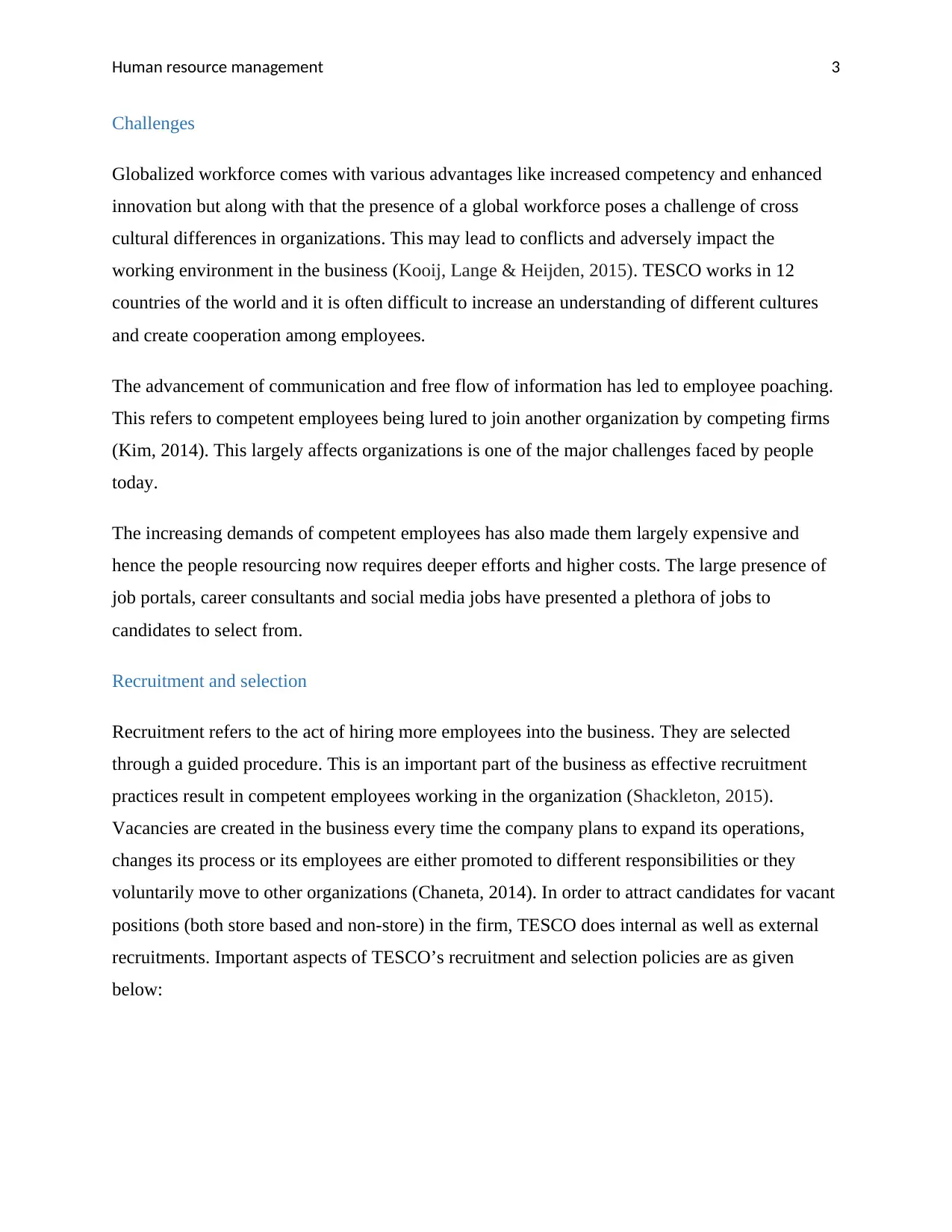
Human resource management 3
Challenges
Globalized workforce comes with various advantages like increased competency and enhanced
innovation but along with that the presence of a global workforce poses a challenge of cross
cultural differences in organizations. This may lead to conflicts and adversely impact the
working environment in the business (Kooij, Lange & Heijden, 2015). TESCO works in 12
countries of the world and it is often difficult to increase an understanding of different cultures
and create cooperation among employees.
The advancement of communication and free flow of information has led to employee poaching.
This refers to competent employees being lured to join another organization by competing firms
(Kim, 2014). This largely affects organizations is one of the major challenges faced by people
today.
The increasing demands of competent employees has also made them largely expensive and
hence the people resourcing now requires deeper efforts and higher costs. The large presence of
job portals, career consultants and social media jobs have presented a plethora of jobs to
candidates to select from.
Recruitment and selection
Recruitment refers to the act of hiring more employees into the business. They are selected
through a guided procedure. This is an important part of the business as effective recruitment
practices result in competent employees working in the organization (Shackleton, 2015).
Vacancies are created in the business every time the company plans to expand its operations,
changes its process or its employees are either promoted to different responsibilities or they
voluntarily move to other organizations (Chaneta, 2014). In order to attract candidates for vacant
positions (both store based and non-store) in the firm, TESCO does internal as well as external
recruitments. Important aspects of TESCO’s recruitment and selection policies are as given
below:
Challenges
Globalized workforce comes with various advantages like increased competency and enhanced
innovation but along with that the presence of a global workforce poses a challenge of cross
cultural differences in organizations. This may lead to conflicts and adversely impact the
working environment in the business (Kooij, Lange & Heijden, 2015). TESCO works in 12
countries of the world and it is often difficult to increase an understanding of different cultures
and create cooperation among employees.
The advancement of communication and free flow of information has led to employee poaching.
This refers to competent employees being lured to join another organization by competing firms
(Kim, 2014). This largely affects organizations is one of the major challenges faced by people
today.
The increasing demands of competent employees has also made them largely expensive and
hence the people resourcing now requires deeper efforts and higher costs. The large presence of
job portals, career consultants and social media jobs have presented a plethora of jobs to
candidates to select from.
Recruitment and selection
Recruitment refers to the act of hiring more employees into the business. They are selected
through a guided procedure. This is an important part of the business as effective recruitment
practices result in competent employees working in the organization (Shackleton, 2015).
Vacancies are created in the business every time the company plans to expand its operations,
changes its process or its employees are either promoted to different responsibilities or they
voluntarily move to other organizations (Chaneta, 2014). In order to attract candidates for vacant
positions (both store based and non-store) in the firm, TESCO does internal as well as external
recruitments. Important aspects of TESCO’s recruitment and selection policies are as given
below:
Paraphrase This Document
Need a fresh take? Get an instant paraphrase of this document with our AI Paraphraser
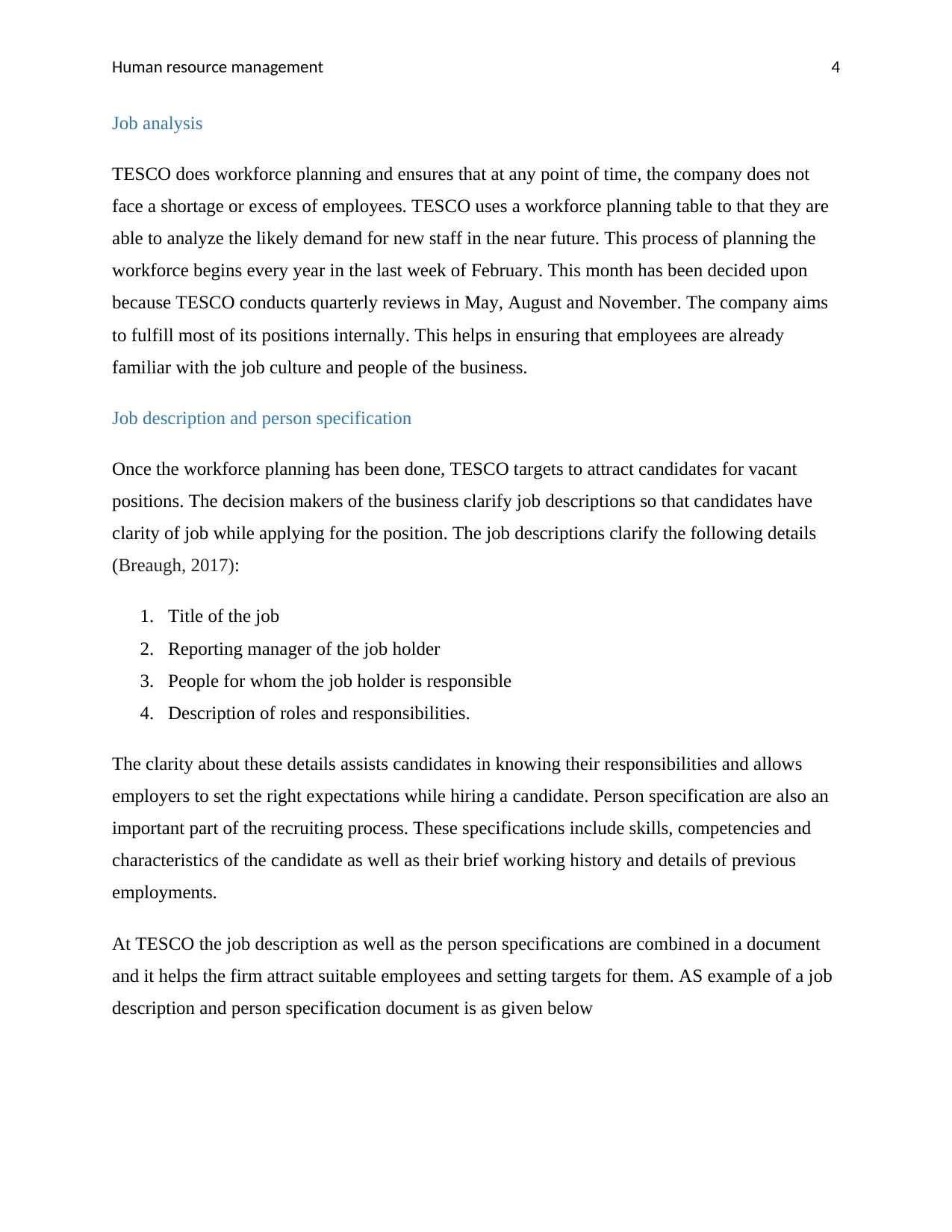
Human resource management 4
Job analysis
TESCO does workforce planning and ensures that at any point of time, the company does not
face a shortage or excess of employees. TESCO uses a workforce planning table to that they are
able to analyze the likely demand for new staff in the near future. This process of planning the
workforce begins every year in the last week of February. This month has been decided upon
because TESCO conducts quarterly reviews in May, August and November. The company aims
to fulfill most of its positions internally. This helps in ensuring that employees are already
familiar with the job culture and people of the business.
Job description and person specification
Once the workforce planning has been done, TESCO targets to attract candidates for vacant
positions. The decision makers of the business clarify job descriptions so that candidates have
clarity of job while applying for the position. The job descriptions clarify the following details
(Breaugh, 2017):
1. Title of the job
2. Reporting manager of the job holder
3. People for whom the job holder is responsible
4. Description of roles and responsibilities.
The clarity about these details assists candidates in knowing their responsibilities and allows
employers to set the right expectations while hiring a candidate. Person specification are also an
important part of the recruiting process. These specifications include skills, competencies and
characteristics of the candidate as well as their brief working history and details of previous
employments.
At TESCO the job description as well as the person specifications are combined in a document
and it helps the firm attract suitable employees and setting targets for them. AS example of a job
description and person specification document is as given below
Job analysis
TESCO does workforce planning and ensures that at any point of time, the company does not
face a shortage or excess of employees. TESCO uses a workforce planning table to that they are
able to analyze the likely demand for new staff in the near future. This process of planning the
workforce begins every year in the last week of February. This month has been decided upon
because TESCO conducts quarterly reviews in May, August and November. The company aims
to fulfill most of its positions internally. This helps in ensuring that employees are already
familiar with the job culture and people of the business.
Job description and person specification
Once the workforce planning has been done, TESCO targets to attract candidates for vacant
positions. The decision makers of the business clarify job descriptions so that candidates have
clarity of job while applying for the position. The job descriptions clarify the following details
(Breaugh, 2017):
1. Title of the job
2. Reporting manager of the job holder
3. People for whom the job holder is responsible
4. Description of roles and responsibilities.
The clarity about these details assists candidates in knowing their responsibilities and allows
employers to set the right expectations while hiring a candidate. Person specification are also an
important part of the recruiting process. These specifications include skills, competencies and
characteristics of the candidate as well as their brief working history and details of previous
employments.
At TESCO the job description as well as the person specifications are combined in a document
and it helps the firm attract suitable employees and setting targets for them. AS example of a job
description and person specification document is as given below

Human resource management 5
Short listing
In order to attract candidates, TESCO places ads in their store vacancy boards, TESCO website,
television and magazines. In order to ensure that the suitable candidates apply for job, TESCO
has also provided a job type match model on their website to guide candidates in their
application process.
Once a number of candidates have applied for the position, the right candidate needs to be
selected who is most suited for the job. In the first stage of screening, employee’s CV is browsed
and analyzed. People whose skills, competencies and prior work experiences suit those required
by TESCO are then promoted to the next level of screening.
Candidates to clear the CV screening are then asked to attend assessment centers. These
assessments take place in stores and are run by store managers. In this process, applicants are
given various activities to perform. Through the entire course they are tested upon different areas
like communication, decision making and team building. The shortlisted candidates then move
on to their interview rounds.
Interviewing
Interviewing is a process of face to face interaction between the candidate and the employer.
The line managers are involved in the process as they are the ones who would be directly
working with the candidate. Interview process helps employers gain a deeper insight about the
Short listing
In order to attract candidates, TESCO places ads in their store vacancy boards, TESCO website,
television and magazines. In order to ensure that the suitable candidates apply for job, TESCO
has also provided a job type match model on their website to guide candidates in their
application process.
Once a number of candidates have applied for the position, the right candidate needs to be
selected who is most suited for the job. In the first stage of screening, employee’s CV is browsed
and analyzed. People whose skills, competencies and prior work experiences suit those required
by TESCO are then promoted to the next level of screening.
Candidates to clear the CV screening are then asked to attend assessment centers. These
assessments take place in stores and are run by store managers. In this process, applicants are
given various activities to perform. Through the entire course they are tested upon different areas
like communication, decision making and team building. The shortlisted candidates then move
on to their interview rounds.
Interviewing
Interviewing is a process of face to face interaction between the candidate and the employer.
The line managers are involved in the process as they are the ones who would be directly
working with the candidate. Interview process helps employers gain a deeper insight about the
⊘ This is a preview!⊘
Do you want full access?
Subscribe today to unlock all pages.

Trusted by 1+ million students worldwide

Human resource management 6
candidates and their competencies and skills. Similarly, this conversation also allows candidates
to ask any questions and clarify any doubts as they arise in order to build the right expectation
setting with the organization (Foster, 2017). Salary negotiations may also take place in the
interviewing process. After this process, the candidates who are shortlisted are finally offered a
job with the firm.
Induction process
Every time a new employee joins the organization, it is the role and responsibility of the
organization to ensure that the employee gets accustomed to the organizational history, culture,
processes and people. This process of enabling employees to get familiar with the organization is
called induction (Hudson, 2016). This is an important part in the tenure of every employee.
Inductions enables in breaking the ice between the employee and the firm. This process is
planned with an aim to provide a platform of free information flow for the employees as well as
addressing their doubts and inhibitions regarding the firm.
Induction process has various advantages as listed below:
Acts as an ice breaker in the initial days of work. Employees are often nervous and shy in
their initial days of work. Induction program familiarizes employees and acts as an ice
breaker between the new and existing employees.
Accustoms the new joined employee with the company policies, procedure and history.
These details eventually helps the employee in following protocol and reduces chances of
error (Srimannarayana, 2016).
At the time of joining, an employee has various queries and doubts, these issues and
questions are addressed during the induction program.
Clarify roles and responsibilities to the employee.
Leads to integration of employee in the new organization (El-Shamy, 2016)
The process of induction must be well planned and effectively executed so as to ensure
maximum benefit from the same. There are various challenges that may be faced due to
inefficacy of the induction program offered to new employees by the company:
candidates and their competencies and skills. Similarly, this conversation also allows candidates
to ask any questions and clarify any doubts as they arise in order to build the right expectation
setting with the organization (Foster, 2017). Salary negotiations may also take place in the
interviewing process. After this process, the candidates who are shortlisted are finally offered a
job with the firm.
Induction process
Every time a new employee joins the organization, it is the role and responsibility of the
organization to ensure that the employee gets accustomed to the organizational history, culture,
processes and people. This process of enabling employees to get familiar with the organization is
called induction (Hudson, 2016). This is an important part in the tenure of every employee.
Inductions enables in breaking the ice between the employee and the firm. This process is
planned with an aim to provide a platform of free information flow for the employees as well as
addressing their doubts and inhibitions regarding the firm.
Induction process has various advantages as listed below:
Acts as an ice breaker in the initial days of work. Employees are often nervous and shy in
their initial days of work. Induction program familiarizes employees and acts as an ice
breaker between the new and existing employees.
Accustoms the new joined employee with the company policies, procedure and history.
These details eventually helps the employee in following protocol and reduces chances of
error (Srimannarayana, 2016).
At the time of joining, an employee has various queries and doubts, these issues and
questions are addressed during the induction program.
Clarify roles and responsibilities to the employee.
Leads to integration of employee in the new organization (El-Shamy, 2016)
The process of induction must be well planned and effectively executed so as to ensure
maximum benefit from the same. There are various challenges that may be faced due to
inefficacy of the induction program offered to new employees by the company:
Paraphrase This Document
Need a fresh take? Get an instant paraphrase of this document with our AI Paraphraser
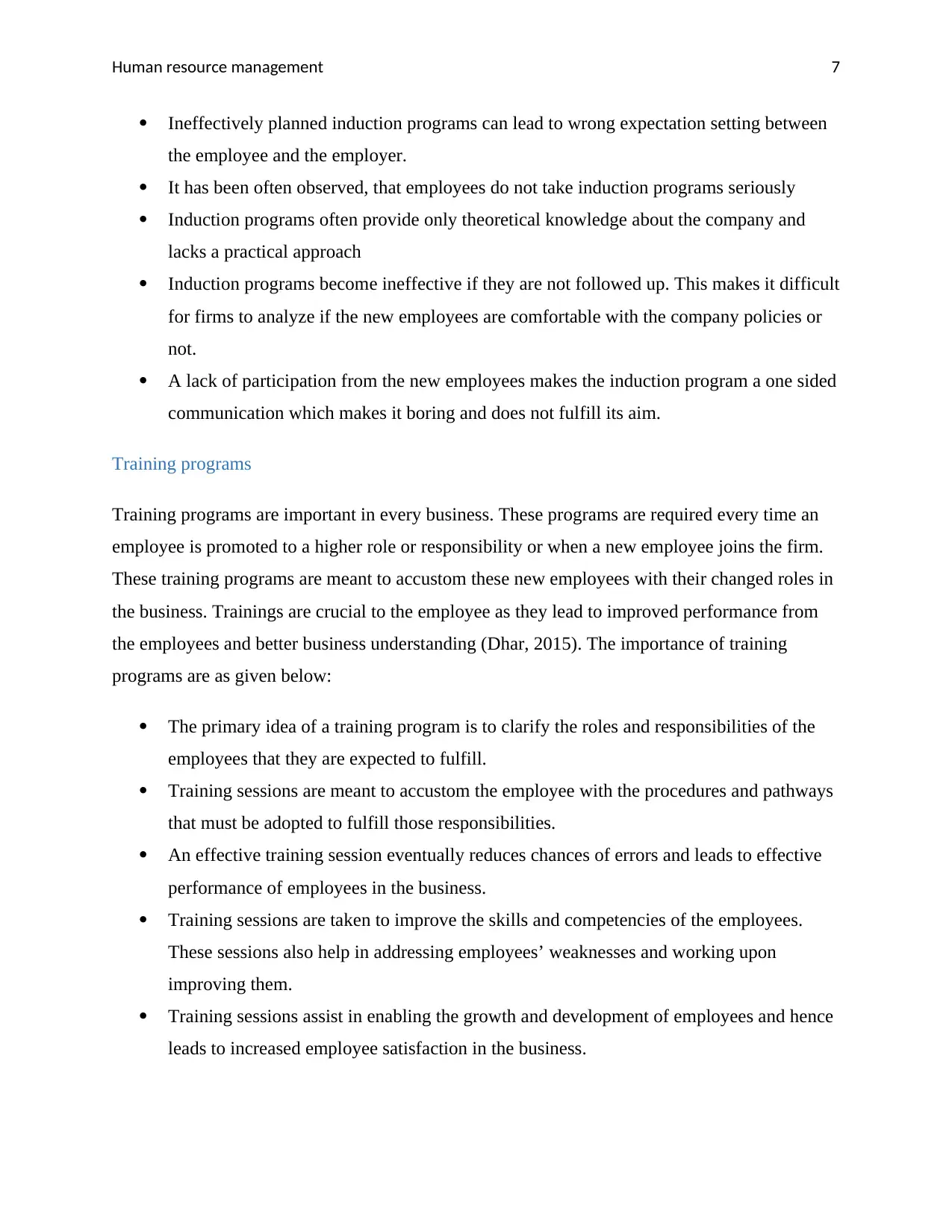
Human resource management 7
Ineffectively planned induction programs can lead to wrong expectation setting between
the employee and the employer.
It has been often observed, that employees do not take induction programs seriously
Induction programs often provide only theoretical knowledge about the company and
lacks a practical approach
Induction programs become ineffective if they are not followed up. This makes it difficult
for firms to analyze if the new employees are comfortable with the company policies or
not.
A lack of participation from the new employees makes the induction program a one sided
communication which makes it boring and does not fulfill its aim.
Training programs
Training programs are important in every business. These programs are required every time an
employee is promoted to a higher role or responsibility or when a new employee joins the firm.
These training programs are meant to accustom these new employees with their changed roles in
the business. Trainings are crucial to the employee as they lead to improved performance from
the employees and better business understanding (Dhar, 2015). The importance of training
programs are as given below:
The primary idea of a training program is to clarify the roles and responsibilities of the
employees that they are expected to fulfill.
Training sessions are meant to accustom the employee with the procedures and pathways
that must be adopted to fulfill those responsibilities.
An effective training session eventually reduces chances of errors and leads to effective
performance of employees in the business.
Training sessions are taken to improve the skills and competencies of the employees.
These sessions also help in addressing employees’ weaknesses and working upon
improving them.
Training sessions assist in enabling the growth and development of employees and hence
leads to increased employee satisfaction in the business.
Ineffectively planned induction programs can lead to wrong expectation setting between
the employee and the employer.
It has been often observed, that employees do not take induction programs seriously
Induction programs often provide only theoretical knowledge about the company and
lacks a practical approach
Induction programs become ineffective if they are not followed up. This makes it difficult
for firms to analyze if the new employees are comfortable with the company policies or
not.
A lack of participation from the new employees makes the induction program a one sided
communication which makes it boring and does not fulfill its aim.
Training programs
Training programs are important in every business. These programs are required every time an
employee is promoted to a higher role or responsibility or when a new employee joins the firm.
These training programs are meant to accustom these new employees with their changed roles in
the business. Trainings are crucial to the employee as they lead to improved performance from
the employees and better business understanding (Dhar, 2015). The importance of training
programs are as given below:
The primary idea of a training program is to clarify the roles and responsibilities of the
employees that they are expected to fulfill.
Training sessions are meant to accustom the employee with the procedures and pathways
that must be adopted to fulfill those responsibilities.
An effective training session eventually reduces chances of errors and leads to effective
performance of employees in the business.
Training sessions are taken to improve the skills and competencies of the employees.
These sessions also help in addressing employees’ weaknesses and working upon
improving them.
Training sessions assist in enabling the growth and development of employees and hence
leads to increased employee satisfaction in the business.
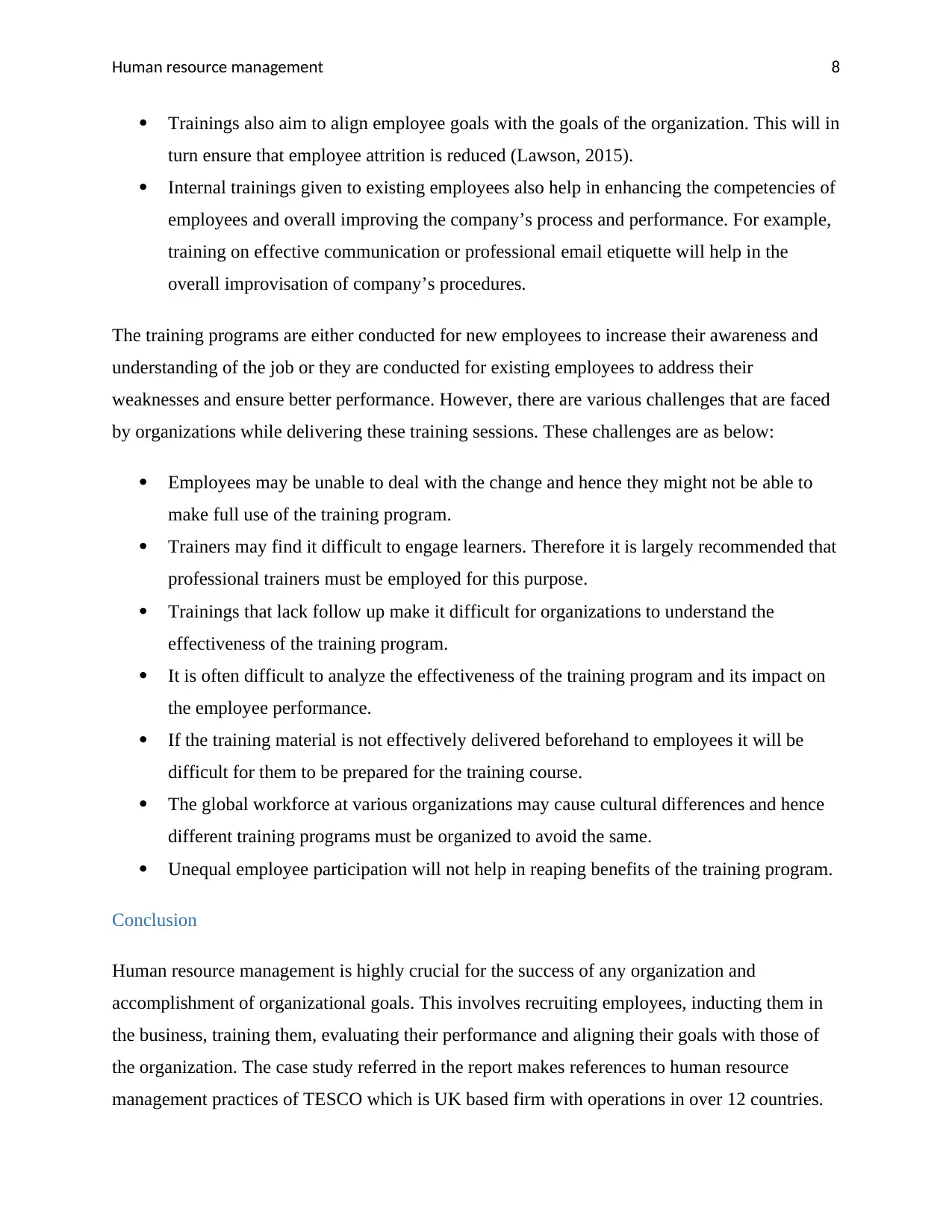
Human resource management 8
Trainings also aim to align employee goals with the goals of the organization. This will in
turn ensure that employee attrition is reduced (Lawson, 2015).
Internal trainings given to existing employees also help in enhancing the competencies of
employees and overall improving the company’s process and performance. For example,
training on effective communication or professional email etiquette will help in the
overall improvisation of company’s procedures.
The training programs are either conducted for new employees to increase their awareness and
understanding of the job or they are conducted for existing employees to address their
weaknesses and ensure better performance. However, there are various challenges that are faced
by organizations while delivering these training sessions. These challenges are as below:
Employees may be unable to deal with the change and hence they might not be able to
make full use of the training program.
Trainers may find it difficult to engage learners. Therefore it is largely recommended that
professional trainers must be employed for this purpose.
Trainings that lack follow up make it difficult for organizations to understand the
effectiveness of the training program.
It is often difficult to analyze the effectiveness of the training program and its impact on
the employee performance.
If the training material is not effectively delivered beforehand to employees it will be
difficult for them to be prepared for the training course.
The global workforce at various organizations may cause cultural differences and hence
different training programs must be organized to avoid the same.
Unequal employee participation will not help in reaping benefits of the training program.
Conclusion
Human resource management is highly crucial for the success of any organization and
accomplishment of organizational goals. This involves recruiting employees, inducting them in
the business, training them, evaluating their performance and aligning their goals with those of
the organization. The case study referred in the report makes references to human resource
management practices of TESCO which is UK based firm with operations in over 12 countries.
Trainings also aim to align employee goals with the goals of the organization. This will in
turn ensure that employee attrition is reduced (Lawson, 2015).
Internal trainings given to existing employees also help in enhancing the competencies of
employees and overall improving the company’s process and performance. For example,
training on effective communication or professional email etiquette will help in the
overall improvisation of company’s procedures.
The training programs are either conducted for new employees to increase their awareness and
understanding of the job or they are conducted for existing employees to address their
weaknesses and ensure better performance. However, there are various challenges that are faced
by organizations while delivering these training sessions. These challenges are as below:
Employees may be unable to deal with the change and hence they might not be able to
make full use of the training program.
Trainers may find it difficult to engage learners. Therefore it is largely recommended that
professional trainers must be employed for this purpose.
Trainings that lack follow up make it difficult for organizations to understand the
effectiveness of the training program.
It is often difficult to analyze the effectiveness of the training program and its impact on
the employee performance.
If the training material is not effectively delivered beforehand to employees it will be
difficult for them to be prepared for the training course.
The global workforce at various organizations may cause cultural differences and hence
different training programs must be organized to avoid the same.
Unequal employee participation will not help in reaping benefits of the training program.
Conclusion
Human resource management is highly crucial for the success of any organization and
accomplishment of organizational goals. This involves recruiting employees, inducting them in
the business, training them, evaluating their performance and aligning their goals with those of
the organization. The case study referred in the report makes references to human resource
management practices of TESCO which is UK based firm with operations in over 12 countries.
⊘ This is a preview!⊘
Do you want full access?
Subscribe today to unlock all pages.

Trusted by 1+ million students worldwide

Human resource management 9
The report highlights upon the importance of effective recruitment practices in the business,
innovative induction programs and efficient trainings. Such programs help in accustoming a new
employee in the organization as well as helps the business set the right expectations for the
employees as and when required. Communication also plays an important role in every
organization and such programs instil a transparency in business communication and helps in
building an environment of trust.
It is largely recommended that every organization must put desired efforts in increasing the
efficacy of their recruitment practices, organizing efficient training programs and finely
inducting employees into the business. This will lead to improved performance of the employee
as well as growth and development of the business.
The report highlights upon the importance of effective recruitment practices in the business,
innovative induction programs and efficient trainings. Such programs help in accustoming a new
employee in the organization as well as helps the business set the right expectations for the
employees as and when required. Communication also plays an important role in every
organization and such programs instil a transparency in business communication and helps in
building an environment of trust.
It is largely recommended that every organization must put desired efforts in increasing the
efficacy of their recruitment practices, organizing efficient training programs and finely
inducting employees into the business. This will lead to improved performance of the employee
as well as growth and development of the business.
Paraphrase This Document
Need a fresh take? Get an instant paraphrase of this document with our AI Paraphraser

Human resource management 10
References
Breaugh, J.A., 2017. To Recruitment. The Wiley Blackwell Handbook of the Psychology of
Recruitment, Selection and Employee Retention, p.12.
Chaneta, I., 2014. Recruitment and Selection. International Journal of Management, IT and
Engineering, 4(2), p.289.
Dhar, R.L., 2015. Service quality and the training of employees: The mediating role of
organizational commitment. Tourism Management, 46, pp.419-430.
El-Shamy, S., 2016. Dynamic induction: Games, activities and ideas to revitalize your employee
induction process. CRC Press.
Foster, E.C., 2014. Human resource management. In Software Engineering (pp. 253-269).
Apress, Berkeley, CA.
Foster, S., 2017. The benefits of values-based recruitment. British Journal of Nursing, 26(10),
pp.579-579.
Gibbs, C., MacDonald, F. and MacKay, K., 2015. Social media usage in hotel human resources:
recruitment, hiring and communication. International Journal of Contemporary Hospitality
Management, 27(2), pp.170-184.
Hendry, C., 2012. Human resource management. Routledge.
Hudson, J., 2016. Case study: A brain-based workplace induction program. Training &
Development, 43(5), p.14.
Kim, J.H., 2014. Employee Poaching: Why It Can Be Predatory. Managerial and Decision
Economics, 35(5), pp.309-317.
References
Breaugh, J.A., 2017. To Recruitment. The Wiley Blackwell Handbook of the Psychology of
Recruitment, Selection and Employee Retention, p.12.
Chaneta, I., 2014. Recruitment and Selection. International Journal of Management, IT and
Engineering, 4(2), p.289.
Dhar, R.L., 2015. Service quality and the training of employees: The mediating role of
organizational commitment. Tourism Management, 46, pp.419-430.
El-Shamy, S., 2016. Dynamic induction: Games, activities and ideas to revitalize your employee
induction process. CRC Press.
Foster, E.C., 2014. Human resource management. In Software Engineering (pp. 253-269).
Apress, Berkeley, CA.
Foster, S., 2017. The benefits of values-based recruitment. British Journal of Nursing, 26(10),
pp.579-579.
Gibbs, C., MacDonald, F. and MacKay, K., 2015. Social media usage in hotel human resources:
recruitment, hiring and communication. International Journal of Contemporary Hospitality
Management, 27(2), pp.170-184.
Hendry, C., 2012. Human resource management. Routledge.
Hudson, J., 2016. Case study: A brain-based workplace induction program. Training &
Development, 43(5), p.14.
Kim, J.H., 2014. Employee Poaching: Why It Can Be Predatory. Managerial and Decision
Economics, 35(5), pp.309-317.
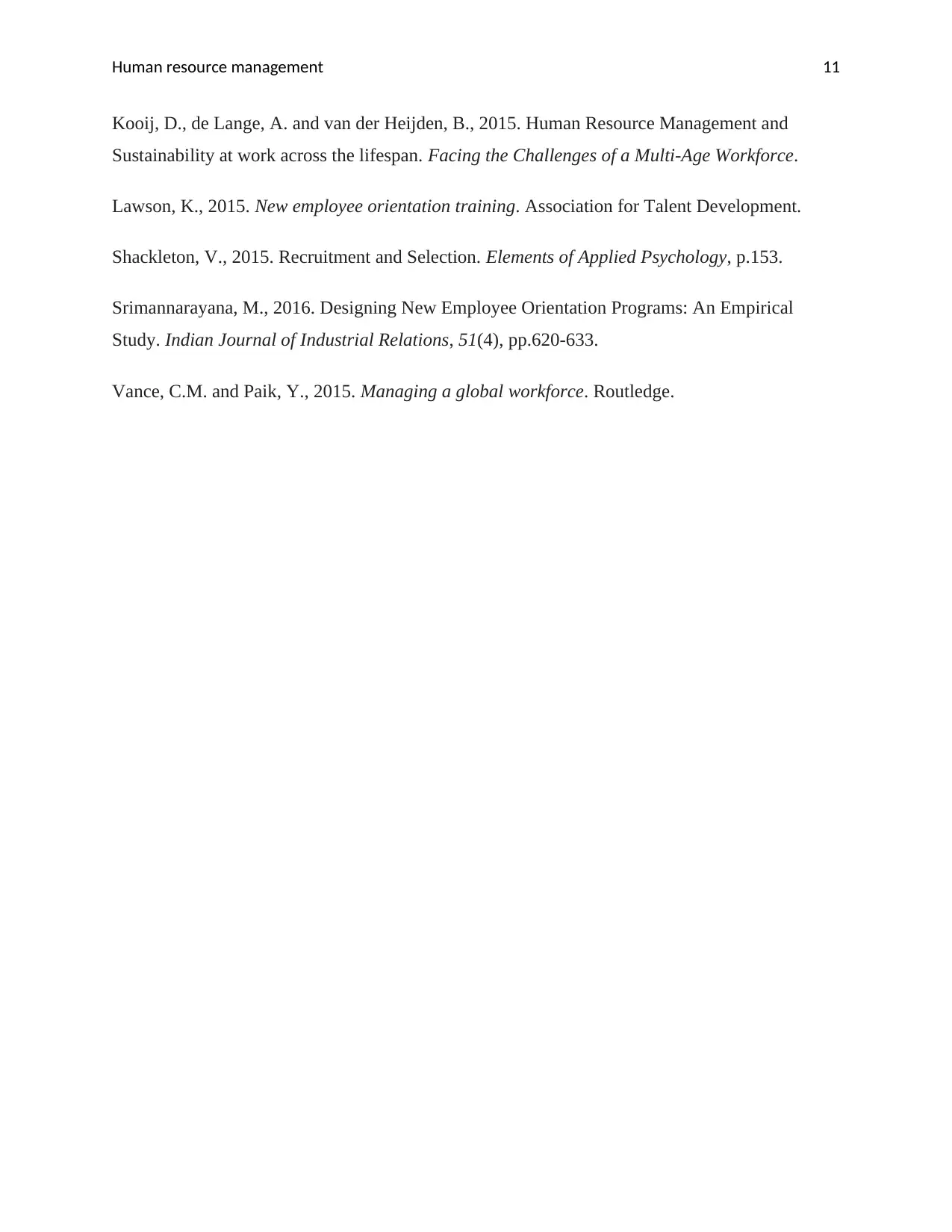
Human resource management 11
Kooij, D., de Lange, A. and van der Heijden, B., 2015. Human Resource Management and
Sustainability at work across the lifespan. Facing the Challenges of a Multi-Age Workforce.
Lawson, K., 2015. New employee orientation training. Association for Talent Development.
Shackleton, V., 2015. Recruitment and Selection. Elements of Applied Psychology, p.153.
Srimannarayana, M., 2016. Designing New Employee Orientation Programs: An Empirical
Study. Indian Journal of Industrial Relations, 51(4), pp.620-633.
Vance, C.M. and Paik, Y., 2015. Managing a global workforce. Routledge.
Kooij, D., de Lange, A. and van der Heijden, B., 2015. Human Resource Management and
Sustainability at work across the lifespan. Facing the Challenges of a Multi-Age Workforce.
Lawson, K., 2015. New employee orientation training. Association for Talent Development.
Shackleton, V., 2015. Recruitment and Selection. Elements of Applied Psychology, p.153.
Srimannarayana, M., 2016. Designing New Employee Orientation Programs: An Empirical
Study. Indian Journal of Industrial Relations, 51(4), pp.620-633.
Vance, C.M. and Paik, Y., 2015. Managing a global workforce. Routledge.
⊘ This is a preview!⊘
Do you want full access?
Subscribe today to unlock all pages.

Trusted by 1+ million students worldwide
1 out of 12
Related Documents
Your All-in-One AI-Powered Toolkit for Academic Success.
+13062052269
info@desklib.com
Available 24*7 on WhatsApp / Email
![[object Object]](/_next/static/media/star-bottom.7253800d.svg)
Unlock your academic potential
Copyright © 2020–2025 A2Z Services. All Rights Reserved. Developed and managed by ZUCOL.





